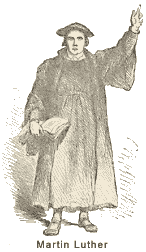The Protestant Reformation was a major 16th century European movement aimed initially at reforming the beliefs and practices of The Roman Catholic Church. Its religious aspects were supplemented by ambitious political rulers who wanted to extend their power and control at the expense of the Church. The Reformation ended the unity imposed by medieval Christianity and, in the eyes of many historians, signaled the beginning of the modern era. A weakening of the old order was already under way in Northern Europe, as evidenced by the emergence of thriving new cities and a determined middle class.
Over the centuries there had been many reform efforts within the Catholic Church, most notably a series of largely unsuccessful church councils. Popular support existed in some quarters for simplifying worship services and requiring a more dedicated clergy.
In 1517, in one of the signal events of western history, Martin Luther, a German Augustinian monk, posted 95 theses on the church door in the university town of Wittenberg. That act was common academic practice of the day and served as an invitation to debate. Luther’s propositions challenged some portions of Roman Catholic doctrine and a number of specific practices.
 Luther argued that the Bible, not the pope, was the central means to discern God’s word — a view that was certain to raise eyebrows in Rome. Further, Luther maintained that justification (salvation) was granted by faith alone; good works and the sacraments were not necessary in order to be saved.
Luther had been especially appalled by a common church practice of the day, the selling of indulgences. These papal documents were sold to penitents and promised them the remission of their sins. To Luther and other critics it appeared that salvation was for sale. Rome enthusiastically supported the use of indulgences as a means to raise money for a massive church project, the construction of St. Peter’s basilica.
There was nothing secret about Luther’s challenges. He sent a copy to his bishop, who in turn forwarded the theses to Rome.
The details of the development and spread of what would become Lutheranism are outside the confines of U.S. history, but it is important to note that the movement quickly gained adherents in the German states, the Netherlands, Scandinavia, Scotland and portions of France. Support came from sincere religious reformers, while others manipulated the movement to gain control of valuable church property.
Not surprisingly, a Counter-Reformation developed to combat the new reforms and bolster the doctrine and practices of the Roman Catholic Church. The undisputed leader of this movement was Spain, then enjoying its “golden century.” With wealth looted from New World sources, Spain was the dominant world power and closest ally of the pope. For a time England, too, remained loyal to Rome. Henry VIII used his writing talents to launch an attack on Lutheranism and was awarded the title of Defender of the Faith by the pope. Henry’s loyalty, of course, later gave way to the more pressing need to preserve the Tudor dynasty.
The term Protestant was not initially applied to the reformers, but later was used to describe all groups protesting Roman Catholic orthodoxy.
Lutheranism would have some impact on the development of American history, but far more important were the efforts of the reformers of the reform movement. Ideas set forth by John Calvin, a French theologian living in Geneva, were particularly influential. The Puritans, Huguenots and Presbyterians played prominently in the settlement of America and in the molding of colonial beliefs and values.
Luther argued that the Bible, not the pope, was the central means to discern God’s word — a view that was certain to raise eyebrows in Rome. Further, Luther maintained that justification (salvation) was granted by faith alone; good works and the sacraments were not necessary in order to be saved.
Luther had been especially appalled by a common church practice of the day, the selling of indulgences. These papal documents were sold to penitents and promised them the remission of their sins. To Luther and other critics it appeared that salvation was for sale. Rome enthusiastically supported the use of indulgences as a means to raise money for a massive church project, the construction of St. Peter’s basilica.
There was nothing secret about Luther’s challenges. He sent a copy to his bishop, who in turn forwarded the theses to Rome.
The details of the development and spread of what would become Lutheranism are outside the confines of U.S. history, but it is important to note that the movement quickly gained adherents in the German states, the Netherlands, Scandinavia, Scotland and portions of France. Support came from sincere religious reformers, while others manipulated the movement to gain control of valuable church property.
Not surprisingly, a Counter-Reformation developed to combat the new reforms and bolster the doctrine and practices of the Roman Catholic Church. The undisputed leader of this movement was Spain, then enjoying its “golden century.” With wealth looted from New World sources, Spain was the dominant world power and closest ally of the pope. For a time England, too, remained loyal to Rome. Henry VIII used his writing talents to launch an attack on Lutheranism and was awarded the title of Defender of the Faith by the pope. Henry’s loyalty, of course, later gave way to the more pressing need to preserve the Tudor dynasty.
The term Protestant was not initially applied to the reformers, but later was used to describe all groups protesting Roman Catholic orthodoxy.
Lutheranism would have some impact on the development of American history, but far more important were the efforts of the reformers of the reform movement. Ideas set forth by John Calvin, a French theologian living in Geneva, were particularly influential. The Puritans, Huguenots and Presbyterians played prominently in the settlement of America and in the molding of colonial beliefs and values.